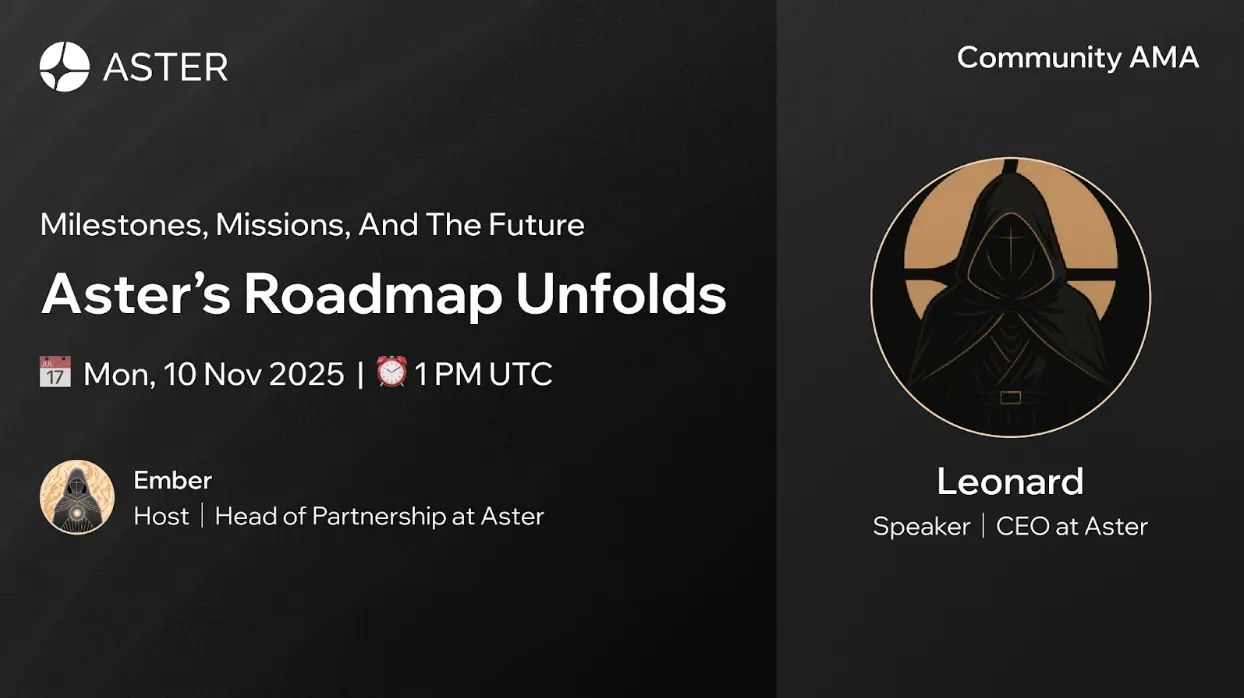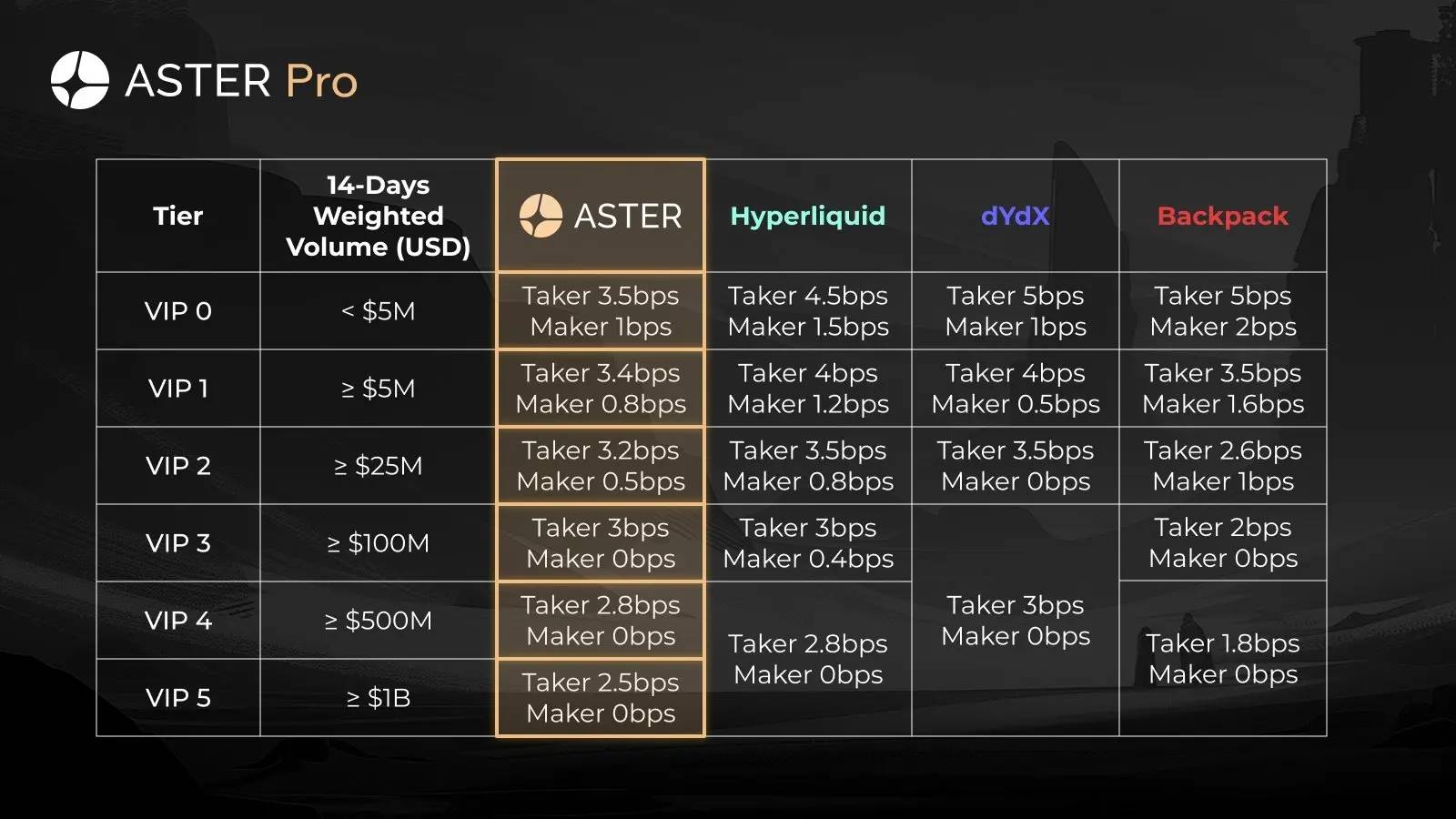Written by: TechFlow
Introduction
The market is shrouded in gloom, but a very few projects are still thriving, and Aster is one of them.
According to CoinGecko data on November 19, $ASTER rose more than 7.7% in the past 24 hours, 18.4% in the past 7 days, and 32.1% in the past 14 days.
As one of the most successful TGE projects this year, after witnessing Aster's over 2800% surge within a week of TGE, the market has become even more focused on Aster's future trajectory.
After all, with so many projects peaking at TGE, only those that can sustain users, trading, and revenue post-TGE can be considered to have truly withstood the test of the market and community.
At the same time, with 2025 poised to be a year of explosive growth for Perp DEXs, Aster's breakout battle will become even more interesting amid competition from products like Hyperliquid, Lighter, EdgeX, and others in the same track.
So, what is Aster's core competitive strategy?
From launching Rocket Launch to provide users with early access to quality assets, to introducing a privacy-focused Layer 1, and empowering the $ASTER token through staking/buyback/burn/fee discounts and other mechanisms... On November 10, 2025, Aster founder Leonard gave a clear answer in a direct community AMA session:
The market does not need another repetitive and boring Perp DEX, but rather true trading freedom, which integrates a series of needs such as security, trust, privacy, efficiency, cost, liquidity, and yield discovery and capture.
And Aster is reconstructing the on-chain trading ecosystem, achieving true stability and long-term growth on the path of on-chain finance.

An AMA Aimed at Clarifying Aster’s Future: What Did the Founder Say?
Summing up this hour-long AMA, you can easily grasp the following key points:
-
Aster is building a privacy-focused Layer 1: The team is going all out, hoping to complete internal testing and be technically ready for the testnet before early 2026.
-
Continued empowerment of the $ASTER token: Previously, Aster had launched specific use cases around $ASTER such as fee discounts, airdrops, VIP tiers, and continues to empower token value through buyback and burn plans. In the future, as Layer 1 launches, the $ASTER token will unlock more utilities in scenarios such as validation, staking, and governance.
-
Diversified trading assets: In addition to continuously expanding cryptocurrency support, Aster will extend support to gold, stocks, commodities, and other assets.
-
Optimizing liquidity incentives: Continuously attracting and rewarding market makers, incentivizing professional large-pair market makers while also supporting those focused on providing liquidity for long-tail markets.
-
Degen direction exploration: Launching and continuously operating Rocket Launch, giving users early value capture capabilities.
-
Building a global cooperation network: Improving the trading ecosystem landscape to bring richer experiences.
Each line seems independent, but together they form a synergy, further creating a trading environment that is truly attractive to all participants in the trading ecosystem, including traders, institutions, token holders, and market makers.

After TGE, Aster Reaches New Heights
The huge success of TGE was like a traffic tsunami, bringing a surge of users, trading volume, and community discussion to Aster.
After the successful conclusion of TGE, how to effectively retain users in the future is something Aster, as a trading platform, has its own secret recipe for.
In Aster founder Leonard's plan, this is a dual-track path of horizontally expanding yield and vertically deepening experience.
To retain users, you must first make trading comfortable for them, which means a series of experience optimizations. Aster is built specifically for traders, aiming to create a trading ecosystem that combines CEX-level smoothness with DEX-level trust. For traders, especially professional traders or institutional users, Aster has a series of advantages:
On one hand, under a decentralized architecture, Aster can list tokens faster and expand trading assets more flexibly: Aster remains permissionless and open, supporting not only cryptocurrencies but also US stocks, gold, and other assets. In the future, it will expand to more US stocks and commodities, providing a rich selection of trading assets for different traders on-chain.
On the other hand, Aster continues to advance refined liquidity management. The market maker program aims to incentivize LPs to fill markets with weaker depth. While greatly optimizing depth for mainstream tokens, Aster will focus on long-tail assets in the future, planning to offer higher rebate rewards to market makers of small tokens to improve depth and trade quality, allowing users to enjoy smooth, low-slippage experiences regardless of the asset traded.
Privacy features are a major differentiator for Aster compared to other Perp DEX platforms. Many users, especially institutional traders, do not want all their strategies and positions to be publicly visible on-chain. Aster's Hidden Orders and hidden order system can meet this need well, helping to attract more institutional capital.
In addition, features like 1001x extreme leverage and fee advantages will further bring scalable cost differences for large institutions or high-leverage traders.
Besides trading experience, traders care more about "earning," which fits Aster's core philosophy: Trade & Earn
Stable yield is a key module of Aster. Aster aims to provide users, especially institutional users, with more efficient capital utilization through this module. By combining lending, perpetuals, and yield pool mechanisms, it seeks to improve capital returns while maintaining controllable risk. In the future, Aster will also expand to more DeFi partners to bring more yield scenarios.
USDF is the core of Aster's stable yield module. In Aster's trading system, USDF serves as trading collateral, a liquidity asset, and a source of passive income. As a delta-neutral yield stablecoin, USDF mainly generates yield by investing underlying assets into low-risk DeFi protocols.
After TGE, Aster also launched multiple incentive initiatives for users. On one hand, it continues to carry out Stage 3 and Stage 4 activities; on the other, it launched the Double Harvest trading competition with a total prize pool of $10 million, attracting users through real trading rewards and driving platform ecosystem growth.
Another noteworthy move after TGE is the launch of Rocket Launch. As the core vehicle for promoting Aster's "liquidity support" value, Rocket Launch provides a launch platform with both trading depth and long-term value for high-potential projects. Project teams can set up prize pools on the platform to reach a wider user base, while users have an entry point to embrace Degen and capture early opportunities. Since its launch, 5 projects have gone live, with cumulative rewards exceeding $3 million.

Since TGE, Aster's growth logic has been validated by concrete data:
According to official Aster data, the user base has exceeded 4.6 million; according to Dune data, Aster's 24-hour open interest is $2.329 billions, weekly trading volume exceeds $25.6 billions, and its Perp DEX market share is over 20%.
Although several metrics have declined due to the bear market, they still strongly prove that Aster has firmly established itself as a top player in the Perp DEX track.
While continuing to advance the dual-track path of horizontally expanding yield and vertically deepening experience, with the ongoing Layer 1 strategy, Aster's trading ecosystem now has even greater potential for development.
Aster Layer 1: Narrative Upgrade from Perp DEX to Trading Infrastructure
In Aster founder Leonard's AMA, the most attention-grabbing topic was Aster Layer 1.
Building Layer 1 is building infrastructure, and Aster Layer 1 aims to create a chain reconstructed specifically for trading.
Why build a new chain? The core issue returns to Aster's original intention: to realize a truly decentralized, yet CEX-like trading environment on-chain.
On one hand, Aster believes that the trading ecosystem must be built on a decentralized foundation, because the verifiability and self-custody capabilities brought by blockchain can lay a strong foundation of trust for the entire ecosystem;
On the other hand, for the trading ecosystem, the core is order book matching. Aster needs an infrastructure that can provide matching performance close to centralized systems. However, most existing public chain solutions run matching either in contracts or off-chain systems, treating blockchain merely as a data recorder, which brings many limitations.
At the same time, if we look purely at matching performance, Aster founder Leonard believes that currently no chain can beat centralized matching engines and databases. Therefore, while pursuing a CEX-like experience, Aster Layer 1 must further find a key point of differentiated competition, and privacy is Aster's answer.
In many cases, traders do not want their trading strategies to be fully transparent on-chain, as this could bring them many additional troubles. Strategy privacy becomes increasingly important. The well-known trader James Wynn being targeted on Hyperliquid illustrates this well, and the rising popularity of Zcash further validates market demand. Providing on-chain privacy options is both a current market gap and the key to enabling more users and strategies to operate on-chain.
Based on all the above, Aster Layer 1 has already taken shape:
-
Designed for trading: Aster Layer 1 aims to embed order book logic directly into the blockchain core, writing the entire trading matching process into the consensus and execution layers, including order placement, matching, cancellation, etc., so that the entire chain's resource scheduling and performance optimization are primarily focused on trading, bringing a CEX-like trading experience.
-
Deep reinforcement of privacy and security mechanisms: Privacy has always been Aster's core differentiator, and Aster Layer 1 continues this privacy feature to protect trading strategies and user privacy.
-
Verifiability and self-custody: Breaking the black box dilemma of centralized trading, participants can set trading rules and verify trades.
With the improved infrastructure brought by Aster Layer 1, all ecosystem modules will be strongly connected, bringing a series of chain reactions to the Aster trading ecosystem:
On one hand, it is the underlying optimization of trading experience;
On the other, achieving true "verifiable + self-custody + privacy" will open the door to institutional adoption and help Aster evolve into "trading infrastructure." Whether it's DeFi projects, brokers, exchanges, banks, or payment companies, all traditional financial institutions can directly build on Aster and replicate Aster's "CEX-level smoothness and DEX-level trust" success model:
Aster provides matching engine + liquidity + risk control, while partners provide brand + product + local operations.
In the future, Aster will start from Asia and further expand into English-speaking markets, continuously expanding its global partner network to achieve rapid expansion of the Aster trading ecosystem.
At the same time, with the launch of Layer 1 and the staking function, the value cycle of the Aster trading ecosystem will be further closed through the $ASTER token.
All Value Converges on $ASTER
As the core value carrier of the ecosystem, Aster continues to launch specific application scenarios for $ASTER, continuously empowering holders. Currently, the following have been launched:
-
Governance: Token holders can vote on protocol development, including which liquidity sources to integrate, fee structures, fund management, etc.;
-
Fee discounts: Enjoy discounts when paying trading fees with $ASTER;
-
VIP tiers: A multi-level VIP ladder system is established based on trading volume and $ASTER holdings, with higher-level users unlocking deeper fee discounts, priority liquidity access, higher leverage limits, and other benefits;
-
Token airdrops: Holding or staking $ASTER increases your multiplier in Aster Spectra, giving you priority for future airdrops;
-
Activity participation: For example, holding a certain amount of $ASTER is required to participate in Rocket Launch and other activities.
In addition, Aster is also negotiating cooperation with some lending protocols to further provide more use cases for the $ASTER token.

At the same time, Aster has also launched a buyback and burn mechanism to further maintain token value:
Previously, Aster announced that 70%-80% of trading fees generated during S3 would be used to buy back $ASTER. It also stated that of all buyback funds from S2 and S3, 50% would be burned and 50% would be returned to the locked airdrop address, reducing token supply and enhancing its long-term value.
All operations are currently being executed in an orderly manner and are publicly transparent and verifiable, enhancing community trust.

This series of measures greatly weakens the speculative nature of $ASTER, further transforming holders into long-term ecosystem co-builders. At the same time, under the virtuous cycle of "more active trading → higher platform revenue → more buyback and burn → further empowerment of holders," a more sustainable positive flywheel is formed.
After the official launch of Layer 1, the value binding between $ASTER and the entire Aster trading ecosystem will become even closer:
On one hand, validator nodes and staking functions are expected to be launched together with the Aster Layer 1 mainnet. Due to the near-zero Gas design of Layer 1, validator node incentives will be driven by two sources of funds: one is the protocol-level ecosystem incentive allocation, and the other is a share of trading fees. Thanks to Aster's sustained positive cash flow, it can well support the ecosystem in forming a stable and sustainable incentive mechanism, while ecosystem trading behavior is further endowed with the special significance of maintaining network security.
On the other hand, the buyback logic can be directly written into smart contracts for automatic execution, so that the quantity, price, and address of each buyback can be publicly verified, avoiding front-running and information asymmetry, while retaining sufficient algorithmic flexibility to allow different buyback parameters at different stages.
In addition, with the launch of Aster Layer 1, more $ASTER token governance scenarios will be unlocked. Stakers will participate in on-chain governance voting and ecosystem parameter decisions, making the token play a more central governance role in the ecosystem.
Conclusion
From building a Perp DEX product to reconstructing trading infrastructure, Aster is staging a narrative evolution of the underlying operating system for on-chain trading. This leap from the application layer to the infrastructure layer means that Aster is committed to building an ecosystem soil on which countless trading scenarios can grow.
When global DeFi, brokers, exchanges, and financial institutions can quickly build their own derivatives trading platforms based on Aster's infrastructure, the $ASTER token, as the value carrier of this vast ecosystem, will see its potential grow as the ecosystem expands.
It is also worth mentioning that behind this narrative evolution, Aster also carries a distinct "Binance lineage" label: YZi Labs is Aster's backer, and more notably, on the evening of November 2, CZ announced that he had purchased 2.09 million Aster tokens with his own money, marking CZ's strong endorsement of Aster and showing that true industry influencers are voting for Aster's future with real action.
From focusing on trading performance to achieving trading privacy, Aster chose a differentiated competition path for Perp DEXs from its inception and quickly seized Perp DEX market share with its actual performance. Now, as a new round of Perp DEX competition unfolds, will Aster once again stage "TGE-style explosive growth"?
With Aster Layer 1 expected to meet everyone as early as the end of 2025, let us always look forward to the future of on-chain trading.




